Copy Bible Texts
MANUSCRIPT TEXTUAL BASIS FOR FIRST JOHN 5:7:
MANUSCRIPT TEXTUAL BASIS FOR KJV'S TRANSLATION OF 1ST JOHN 5:7.
MANUSCRIPT TEXTUAL BASIS FOR KJV'S TRANSLATION OF 1ST JOHN 5:7
MANUSCRIPT TEXTUAL BASIS FOR KJV'S TRANSLATION OF 1ST JOHN 5:7
MANUSCRIPT TEXTUAL BASIS FOR KJV'S TRANSLATION OF 1ST JOHN 5:7.
MANUSCRIPT TEXTUAL BASIS FOR KJV'S TRANSLATION OF 1ST JOHN 5:7.
MANUSCRIPT TEXTUAL BASIS FOR KJV'S TRANSLATION OF 1ST JOHN 5:7.
MANUSCRIPT TEXTUAL BASIS FOR KJV'S TRANSLATION OF 1ST JOHN 5:7.
MANUSCRIPT TEXTUAL BASIS FOR KJV'S TRANSLATION OF 1ST JOHN 5:7.
The Westcott-Hort/Nestle Greek text of Luke 23:42 is incorrect, being the English-equivalent word "Lord" (κυριε) is omitted in the RSV/NIV-and-others English-mistranslated renditions:
Latin Vulgate [correct]
23:42 et dicebat ad Iesum Domine memento mei cum veneris in regnum tuum
King James Version [correct]
23:42 And he said unto Jesus, Lord, remember me when thou comest into thy kingdom.
American Standard Version [INCORRECT]
23:42 And he said, Jesus, remember me when thou comest in thy kingdom.
Bible in Basic English [INCORRECT]
23:42 And he said, Jesus, keep me in mind when you come in your kingdom.
Darby's English Translation [correct]
23:42 And he said to Jesus, Remember me, Lord, when thou comest in thy kingdom.
Douay Rheims [correct]
23:42 And he said to Jesus: Lord, remember me when thou shalt come into thy kingdom.
Noah Webster Bible [correct]
23:42 And he said to Jesus, Lord, remember me when thou comest into thy kingdom.
- Daniel Roy Bloomquist, S.T.D. (Doctor of Sacred Theology, Honorary)
It has been said that one way to detect whether a large-denomination money
bill is genuine is to feel the contrast with a counterfeit one.
Not only will embedded holograms in the fake bill usually be missing, but the feel
of the "paper" of the real bill is different than that of the fake bill,
being that the real bill is actually a secret type of linen or fabric instead
of mere paper.
However, that is not to say that the only way to really appreciate good is to
discover, know, experience, suffer from, and compare evil.
In other words, do evil that good may come? Or, only by being persecuted are we atoned for
and saved?
Whatever the case, there are two similar passages related to the New Testament
of the Holy Bible.
See if you can discern and determine which one looks more
like authentic Scripture:
#1 = Romans 8:2-4? The redemptive grace of the Spirit of life in Christ Jesus has set
you free from the flesh of sin and death,
because what the flesh could not do, weak as it was because of the law, God did . . . so
that the righteous requirement of faith
might be fulfilled in us who do not walk according to the law but according to
the Spirit.
#2 = Romans 8:2-4? The redemptive law of the Spirit of life in Christ Jesus has set
you free from the law of sin and of death,
because what the law could not do, weak as it was because of the flesh, God did . . . so
that the righteous requirement of the law
might be fulfilled in us who do not walk according to the flesh but according to
the Spirit.
High-School Graduation-Test Final Exam
CRULES (Control Rules)
No Choice: Dangers of "Original Sin" Theology
As to the Easter proclamation, NOT: "He IS risen" but rather: "He HAS risen." Proper grammar, please.
"Is" implies the present, and Christ did not arise in the present but only once 2000 years ago. NOT now!
Similarly, concerning not regarding the hymn: "Jesus Christ IS risen today." Wrong.
No wonder lots of people understandably think that sloppy-semantics mindless bad-grammar Christians are goofs!
Proper wording would instead be: "Jesus Christ was risen back then."
To exacerbate the sordid situation, many of the annual Christmas carols are errantly worded as if the event is occurring now, instead of 2000 years ago.
Add to that silly outmoded Olde-English terminology of thees, thous, thys, and "that" instead of "who"
referring to persons (not objects).
It is high time that real Christians get up to speed with their linguistics.
PRELUDE = J.S. Bach - BWV 582 - Passacaglia c-moll / C minor (notation and music)
Why Believe The Bible
Who is God?
Original Sin Nature?
For All the Saints (Hymn)
Stephen Paulus - Pilgrims' Hymn (with score)
The Road Home - Stephen Paulus
Eric Whitacre - Water Night
Eric Whitacre, Robert Frost - Stopping by Woods on a Snowy Evening (Sleep)
Go Lovely Rose, Eric Whitacre
I Hide Myself (Three Flower Songs)
Whitacre: Three Songs Of Faith: Hope Faith Life Love
There Will Be Rest
Alleluia - Eric Whitacre
Eric Whitacre, born in Reno, Nevada on January 2, 1970, is an American composer, conductor, innovator, and charismatic public speaker. He joined a marching band at school and also played in a techno-pop group. His musical passions broadened and deepened during his years as a student at the University of Nevada, Las Vegas, inspired above all by the life-changing experience of singing Mozart’s Requiem. He completed his first choral composition, ‘Go, lovely rose’, in 1990 as a gift for David Weller, his college choral director. The piece and two companions were published as ‘Three Flower Songs’. He subsequently studied composition with John Corigliano and David Diamond at the Juilliard School in New York, graduating as Master of Music in 1997.
Many of Eric Whitacre’s works have entered the core choral and symphonic repertories and have become the subject of scholarly works and doctoral dissertations. He has received composition awards from the Barlow International Composition Competition, the American Choral Directors Association (ACDA) and the American Composers Forum. In 2001 Eric became the youngest recipient of the ACDA’s coveted Raymond C. Brock commission, an outstanding achievement for a composer who discovered classical music relatively late in life. His list of works includes prestigious commissions for, among others, the BBC Proms, the London Symphony Orchestra and Chorus, Chanticleer, Julian Lloyd Webber and the Philharmonia Orchestra, The Tallis Scholars, the Berlin Rundfunkchor and The King’s Singers. His versatility is also reflected in his collaboration with legendary film composer, Hans Zimmer, with whom he co-wrote the ‘Mermaid Theme’ for Pirates of the Caribbean: On Stranger Tides.
In recent years he has addressed audiences worldwide, at leading universities, the Economist, Seoul Digital Forum and other high-profile global institutions. In October 2012 he presented his Virtual Choir at the Founders conference, an annual private gathering for 150 of the world’s leading technology company founders, and participated in a discussion with YouTube co-founder Jawed Karim. He was invited to the World Economic Forum in Davos in January 2013, where he led a debate on the role of arts in society and the impact of technology on the arts, and gave a presentation to the closing session. He addressed the 2013 Ciudad de las Ideas ‘Brilliant Minds’ conference, a celebration of the most innovative ideas in science, business and culture. His work as creative and cultural leader has also been recognized with an Honorary Patronage from Trinity College Philosophical Society, Dublin, and the award of Alumnus of the Year 2012 by the University of Las Vegas.
Fly To Paradise (VC4) Karaoke
Eric Whitacre -- Fly to Paradise
Cateresy: Atonement by Ingesting Eucharist?
NO "Purgatory"
NO woman should orate in a pulpit nor at a lecturn
near the altar in any Christian church, Islamic mosque, or Jewish synagogue
within a congregation containing men, per First Corinthians 14:33-38 and First Timothy 2:11-14.
Love Hate
Also, NO child 12 and under (noisy or not) should be allowed entrance into any religious-worship sanctuary
per Job 6:24 & 13:5, Psalm 62:1, Proverbs 22:15, Ecclesiastes 3:7, Isaiah 3:12 & 47:5, Habakkuk 2:20,
Zephaniah 1:7 and Zechariah 2:13
Free Will & Blood Sacrifice?
Three Heresies Refuted
Law to Save?
Comparison of Various Bible-Verse Wording in Different Bible Translations
Credibility of Common Sense Science
Roy Moore and the Election of December 2017
Law to Yet Obey, or Faith Only not Fruits-of-the-Spirit Good Works for Salvation?
Trust God?





Pre-Destiny?
This author had previously read about a discrepancy involving two supposedly different Old-Testament Hebrew texts of the Bible:
1. The ben Asher
2. The ben Chayyim
I thus typed in both of them (one at a time) into major internet search engines to investigate.
One KJV-only diehard wrote on the subject, failing to declare that there was once a need for the creation of the at-that-time new King James Version itself, and that "the KJV" has undergone many revision and edition changes.
He mentioned "THE Masoretic Text" without defining if THAT meant the ben Chayyim or the ben Asher text (purportedly discrepant against each other). He condemned Rudolf Kittel and his editor Kahle for putting footnotes in the text of their Stuttgart-edition Hebrew Bible based on a Leningrad Manuscript - with the presumption that Kittel wanted to confuse readers by insinuating that they randomly replace the main text with footnote alterations or substitutions. He went on to state that the American Bible Society offers an 1866-incepted Letteris
(ben Chayyim) Hebrew Old-Testament text for sale, but this author has never seen any such advertisement from ABS at any time ever.
Mr. KJV-only also failed to state WHY the ben Asher Hebrew Text was THE (recognized)
Received Text in authority until the 1500s, but somehow lost that authenticity until Kittel's 1937 edition of ben Asher's Text - which Text the RSV and NASV are thankfully based upon.
Mr. KJV-only gave credence to a certain "Daniel Bomberg" (whoever HE was) and who (according to the preface of the NKJV Bible) concocted and printed a so-called "first rabbinic bible" in 1516 (whatever THAT was)......followed by [oh oh!]: a SECOND edition (the FIRST was NOT GOOD ENOUGH)?
One internet source stated that Jacob ben Chayyim was apparently "some jewish refugee" who the source alleged to have become a Christian (sounds suspicious)! So WHO WAS ben Chayyim, and what were his motives for trashing the
traditional ben Asher Text?
With all this in mind, I synthesized three internet pieces from one Jewish author giving further info about ben Asher:
Aaron ben Moses ben Asher lived in Tiberius during the first half of the 10th century. His family had been involved in creating and maintaining the MASORAH for either five or six generations. Ben Asher rapidly gained fame as
the most authoritative of the Tiberian masoretes, and even after his death, his name continued to hold respect. His vocalization of the Bible is still - for all intents and purposes - THE Text Jews continue
to use.
Moreover, Aaron ben Moses ben Asher was the first to take Hebrew grammar seriously. His SEFER
DIKDUKEI HA-TE'AMIM (Grammar of the Vocalizations) was an original collection of grammatical rules and masoretic information. Grammatical principles were not at that time considered worthy of independent study.
Ben Asher had a tremendous influence on the world of Biblical grammar and scholarship. From documents found in the CAIRO GENIZA, it appears that this most famous masorete (and possibly his family for generations) were also - incidently - KARAITES.
As early as the eighth century, Talmudic rabbis encountered a major challenge. A group of Jews led by Anan ben David declared that they did not accept the authority of the rabbis to interpret Torah. This group, originally called the
Ananites, developed their own understanding of Jewish law based only on the written Torah.
The Ananites were stricter and more rigid than the rabbis in their understanding of Torah law. They simply did not accept the rabbis as legitimate authorities of Jewish law. They denied the authority of the Mishnah and the Gemarra.
It is difficult to determine Ananite doctrines because the Ananites relied on the Torah Text. Anan's famous adage was:"Search thoroughly the Torah and don't rely on my opinions."
In the ninth century, the major group of Ananites combined with other anti-rabbinic groups and became known as the Karaites (followers of the Kra, or Torah Text) in their Masoretic tradition of including VOWELS in the Torah Text. They believed that the Torah had originally been written with vowels, and they viewed such Text as the ONLY legitimate one.
It should not be surprising to discover that many masoretes, so involved in the Masorah, held Karaite beliefs. After all, it was the Karaites who placed such absolute reliance on the Torah Text. It would be natural that they would devote
their lives to studying every aspect of it. The surprising element was that being a Karaite did not disqualify Aaron ben Moses ben Asher in the eyes of Rabbinic Jews.
Codex Leningradensis) is the oldest complete manuscript of the Hebrew Bible in Hebrew, using the masoretic text and Tiberian vocalization.[1] It is dated 1008 CE (or possibly 1009) according to its colophon.[2] The Aleppo Codex, against which the Leningrad Codex was corrected, is several decades older, but parts of it have been missing since 1947, making the Leningrad Codex the oldest complete codex of the Tiberian mesorah that has survived intact to this day.
In modern times, the Leningrad Codex is significant as the Hebrew text reproduced in Biblia Hebraica (1937) and Biblia Hebraica Stuttgartensia (1977). It also serves scholars as a primary source for the recovery of details in the missing parts of the Aleppo Codex.
The biblical text as found in the codex contains the Hebrew letter-text along with Tiberian vowels and cantillation signs. In addition, there are masoretic notes in the margins. There are also various technical supplements dealing with textual and linguistic details, many of which are painted in geometrical forms. The codex is written on parchment and bound in leather.
The Leningrad Codex, in extraordinarily pristine condition after a millennium, also provides an example of medieval Jewish art. Sixteen of the pages contain decorative geometric patterns that illuminate passages from the text. The carpet page shows a star with the names of the scribes on the edges and a blessing written in the middle.
The order of the books in the Leningrad Codex follows the Tiberian textual tradition, which is also that of the later tradition of Sephardic biblical manuscripts. This order for the books differs markedly from that of most printed Hebrew bibles for the books of the Ketuvim. In the Leningrad Codex, the order of the Ketuvim is: Chronicles, Psalms, Job, Proverbs, Ruth, Song of Songs, Ecclesiastes, Lamentations, Esther, Daniel, Ezra-Nehemiah.
According to its colophon, the codex was copied in Cairo from manuscripts written by Aaron ben Moses ben Asher. It has been claimed to be a product of the Asher scriptorium itself.
In its vocalization system (vowel points and cantillation) it is considered by scholars to be the most faithful representative of ben Asher's tradition apart from the Aleppo Codex (edited by ben Asher himself). Its letter-text is not superb.
The codex is now preserved in the National Library of Russia, accessioned as "Firkovich B 19 A". Its former owner, the Crimean Karaite collector Abraham Firkovich, left no indication in his writings where he had acquired the codex, which was taken to Odessa in 1838 and later transferred to the Imperial Library in St Petersburg.
The Leningrad Codex (a codex is a hand-written book as opposed to a scroll) is so named because it has been housed at the National Library of Russia in Saint Petersburg since 1863. In 1924, after the Russian Revolution, Petrograd (formerly Saint Petersburg) was renamed Leningrad, and, because the codex was used as the basic text for the Biblia Hebraica since 1937, it became internationally known as the "Leningrad Codex".
Although in 1991, after the dissolution of the Soviet Union, the city's original name was restored to St Petersburg, the National Library of Russia requested that "Leningrad" be retained in the name of the codex. Nonetheless, the Codex is occasionally referred to as the Codex Petersburgensis or Petropolitanus, or the St. Petersburg Codex. This is ambiguous as, since 1876, these appellations refer to a different biblical codex (MS. Heb B 3) which is even older (916 CE), but contains only the later Prophets.
In 1935, the Leningrad Codex was lent to the Old Testament Seminar of the University of Leipzig for two years while Paul E. Kahle supervised its transcription for the Hebrew text of the third edition of Biblia Hebraica (BHK), published in Stuttgart, 1937. The codex was also used for Biblia Hebraica Stuttgartensia (BHS) in 1977, and is being used for Biblia Hebraica Quinta (BHQ).
As an original work by Tiberian masoretes, the Leningrad Codex was older by several centuries than the other Hebrew manuscripts which had been used for all previous editions of printed Hebrew bibles until Biblia Hebraica.
The Westminster Leningrad Codex is an online digital version of the Leningrad Codex maintained by the J. Alan Groves Center for Advanced Biblical Research at the Westminster Theological Seminary. This is a verified version of the Michigan-Claremont text, transcribed from BHS at the University of Michigan in 1981-1982 under the direction of H. Van Dyke Parunak (of the University of Michigan) and Richard E. Whitaker (of the Institute for Antiquity and Christianity, Claremont Graduate University) with funding from the Packard Foundation and the University of Michigan, with further proofreading and corrections. The online version includes transcription notes and tools for analyzing syntax.
The Leningrad Codex also served as the basis for two important modern Jewish editions of the Hebrew Bible (Tanakh):
* The Dotan edition, which was distributed to soldiers in mass quantities as the official Tanakh of the Israel Defense Forces throughout the 1990s.
* The JPS Hebrew-English Tanakh (Philadelphia, 1999) and the various volumes of the JPS Torah Commentary and JPS Bible Commentary.
For minute masoretic details, however, Israeli and Jewish scholars have shown a marked preference for modern Hebrew editions based upon the Aleppo Codex. These editions use the Leningrad Codex as the most important source (but not the only one) for the reconstruction of parts of the Aleppo Codex that have been missing since 1947.
Comparison of Various Bible-Verse Wording in Different Bible Translations
All-Season Public-Modesty Dress Code
High School
Graduation Final Exam
God FOR Wine!
Convention Speech to Catholics
Counteracting "catholic" Heresies
Polygamy!
Print, re-copy, distribute, and utilize this as an Annual Mate-a-Thon Application and Questionnaire!
Summerwear!
Bare Arms in General-Public View?
Dead Sea Scroll Fragments Available for Online Viewing
English-Hebrew Bible Search by Books and Chapters
Pastor Tom Brock
Scripture Verse Reference Overview
(In Alphabetical - NOT Canonical Arrangement Order)

The Scripture Verse Segments
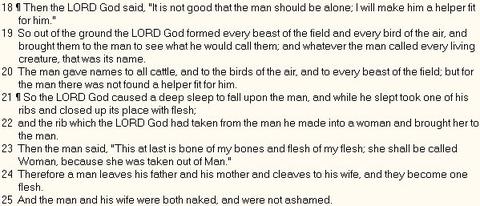
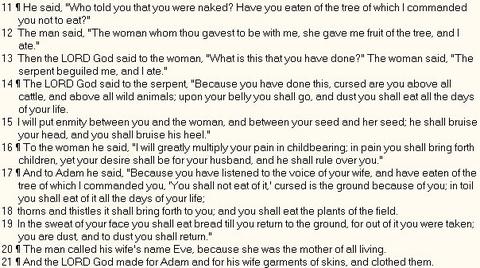
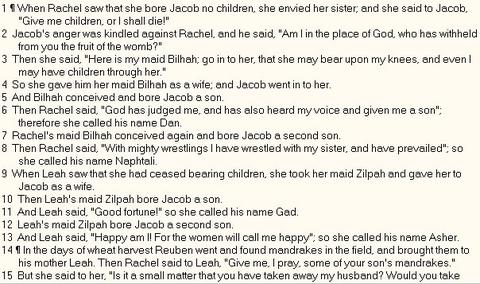

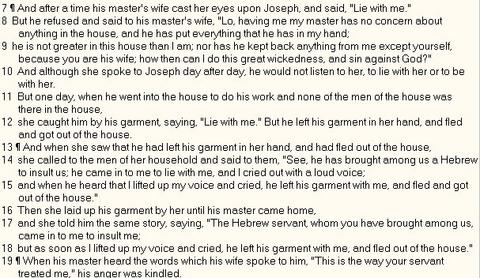

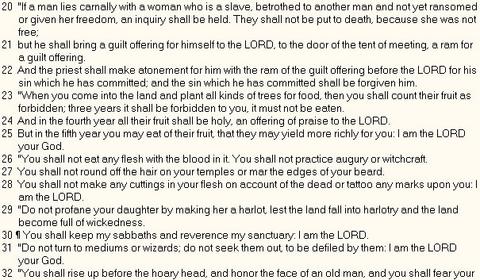

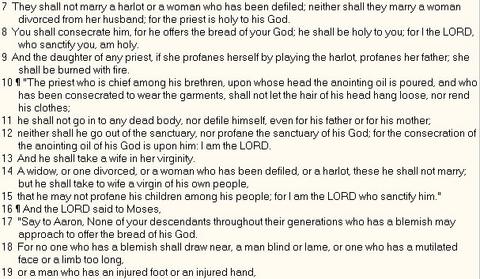
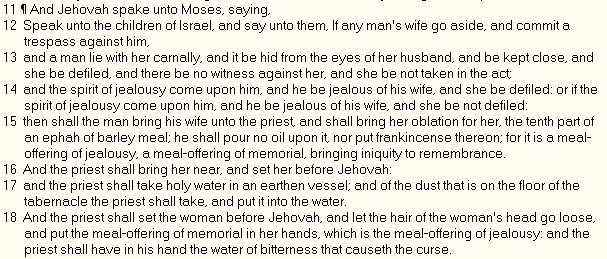
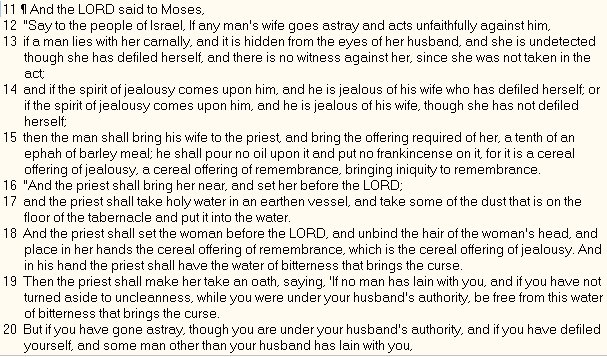
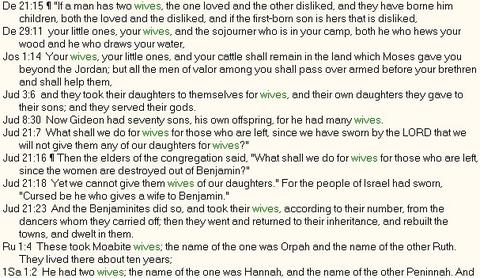
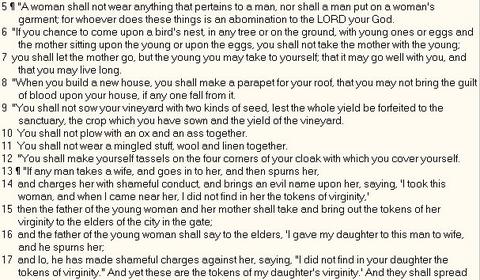
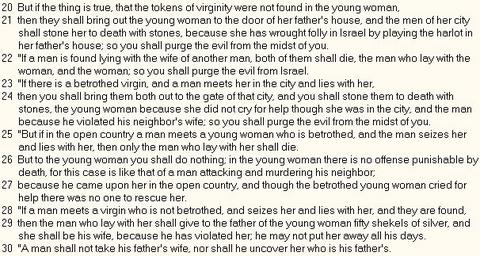
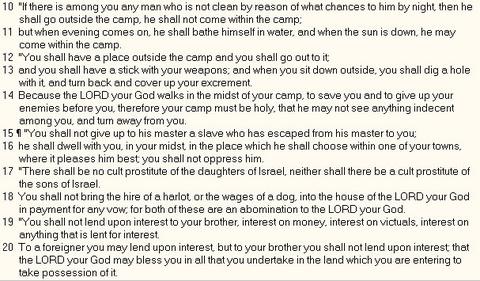
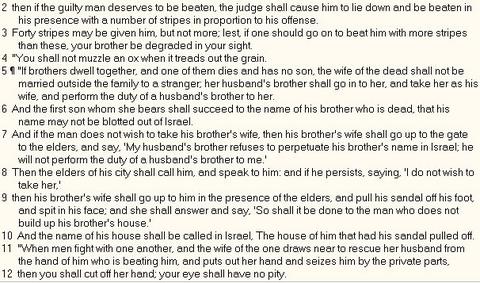

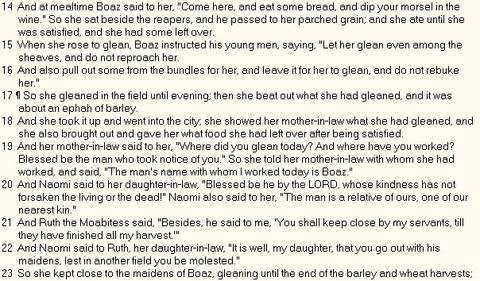

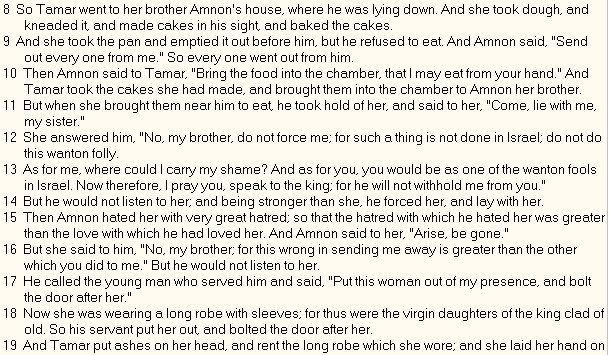
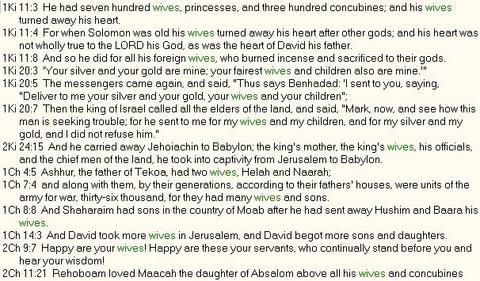

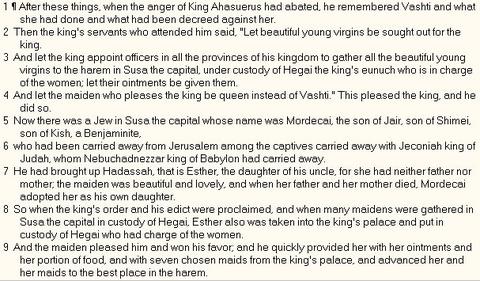
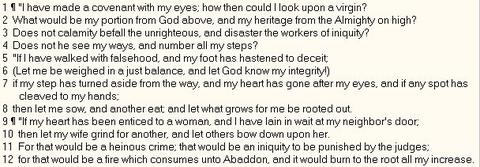
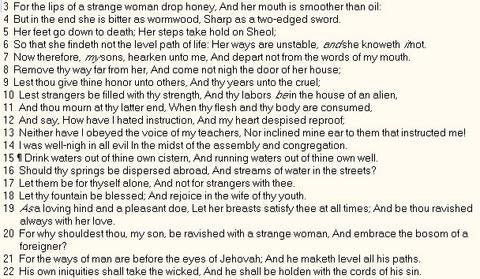
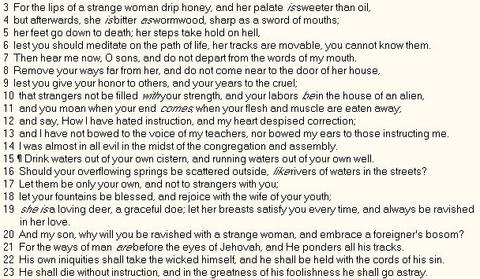
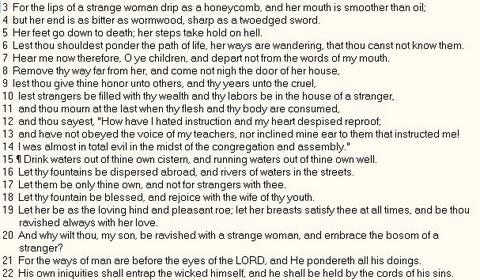
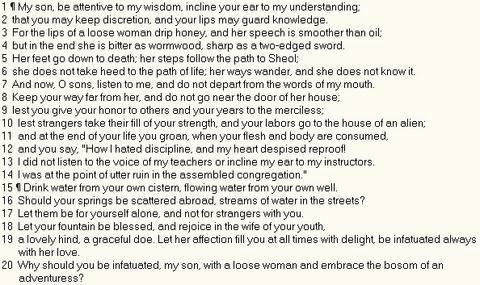
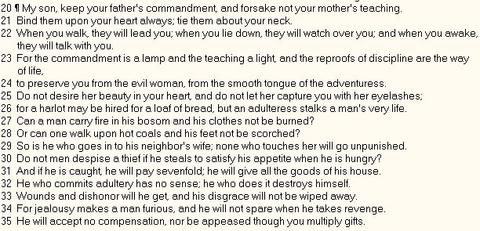
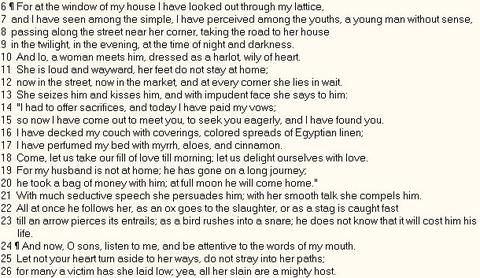
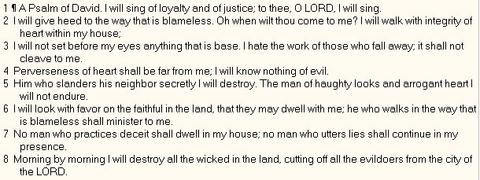
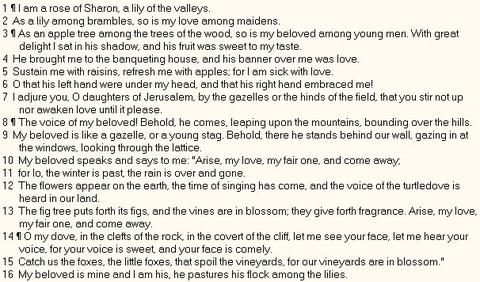
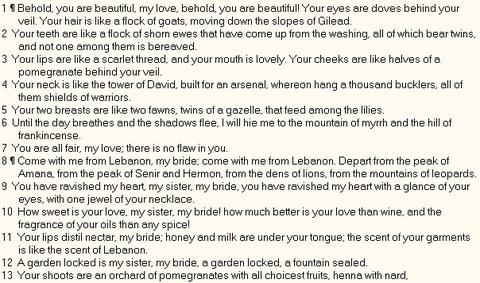
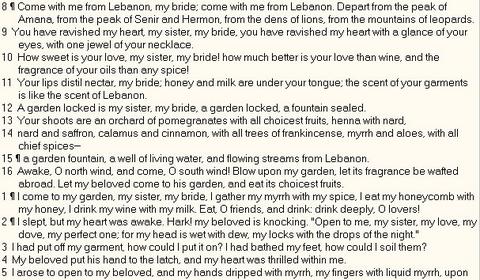
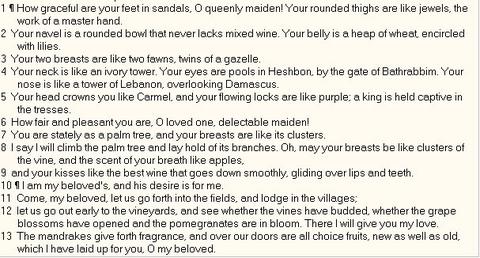
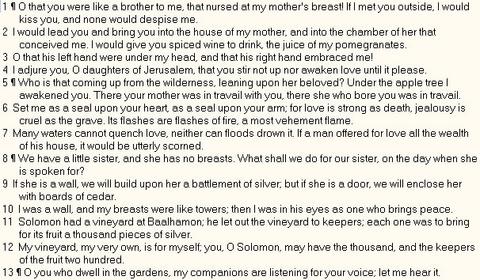
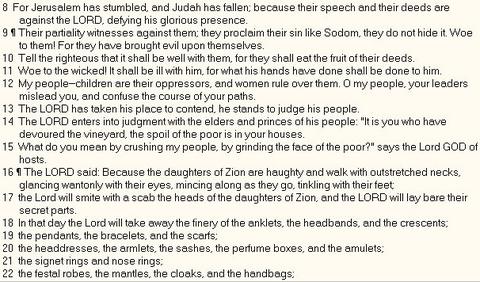
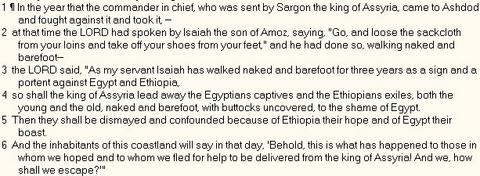

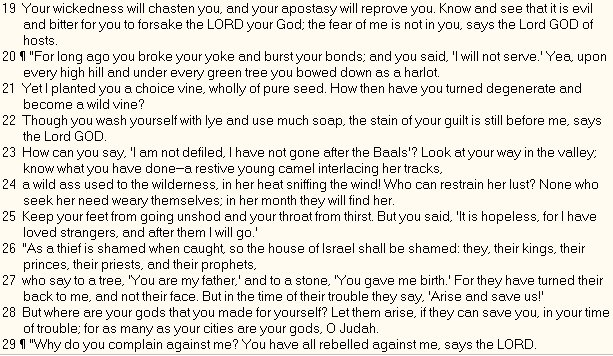
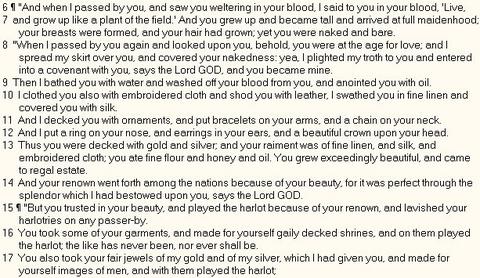
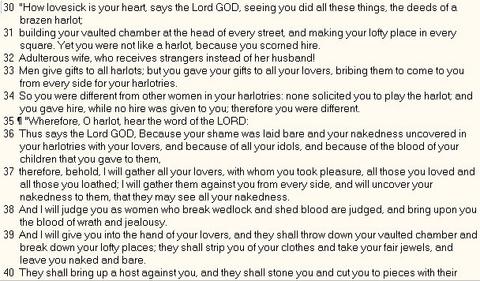
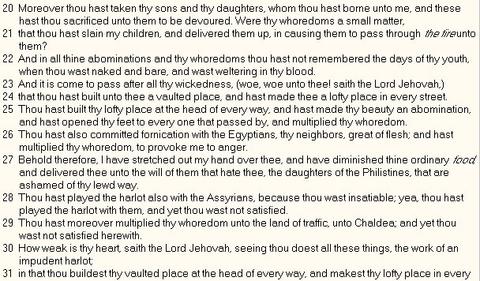
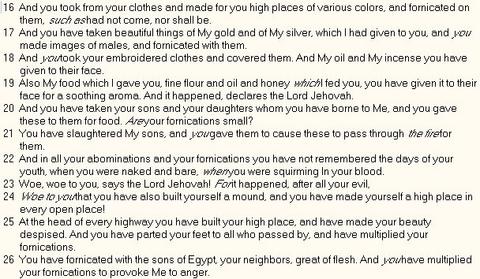

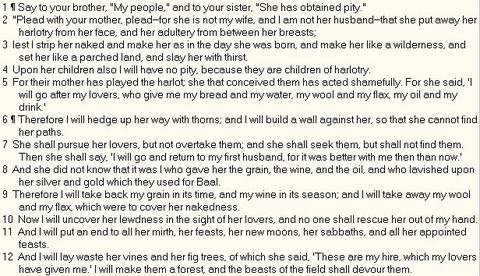
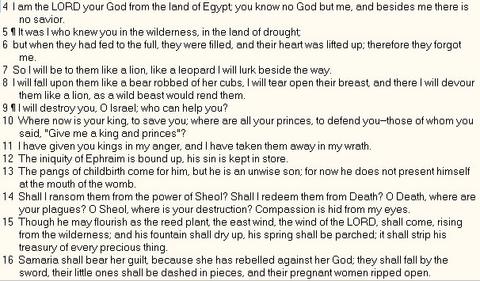

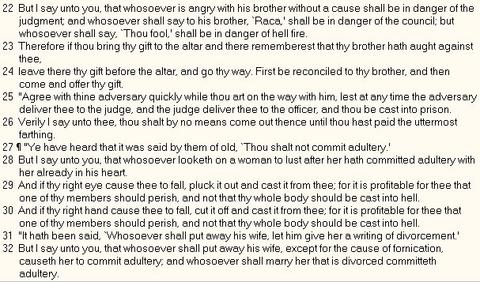
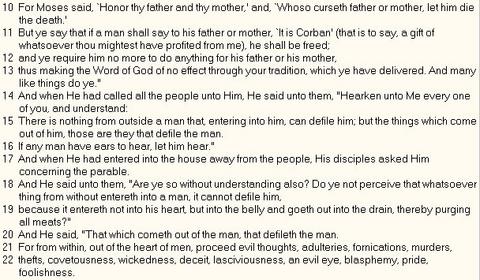
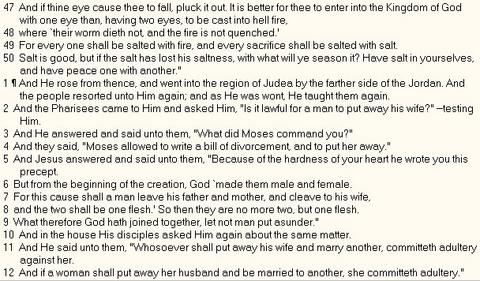

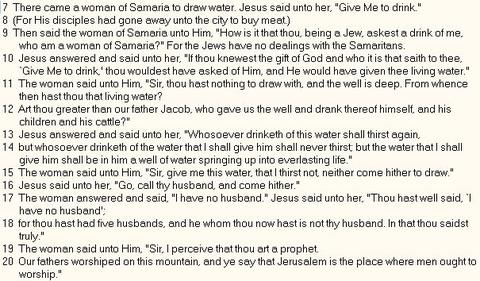
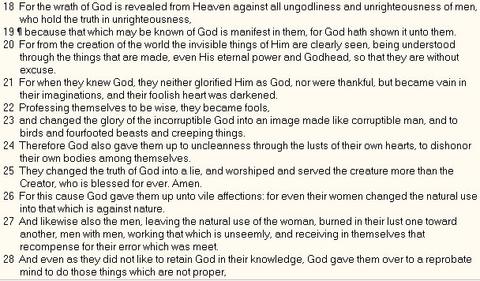

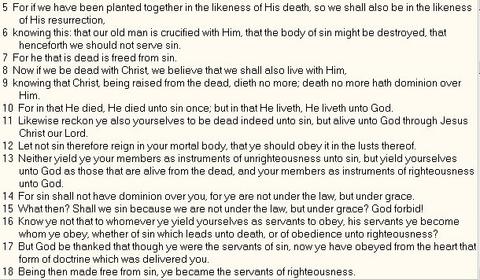
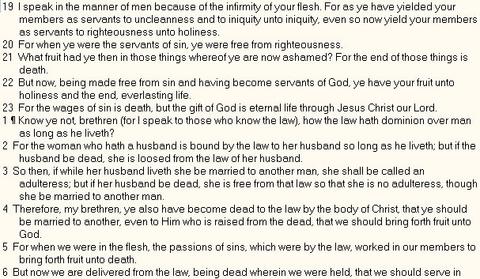
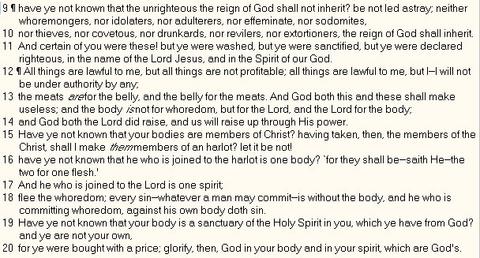
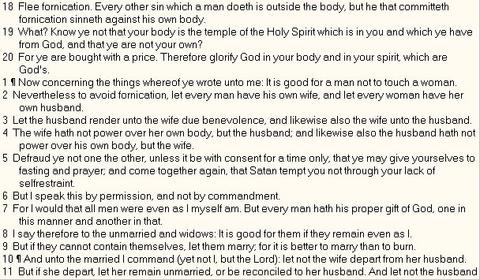
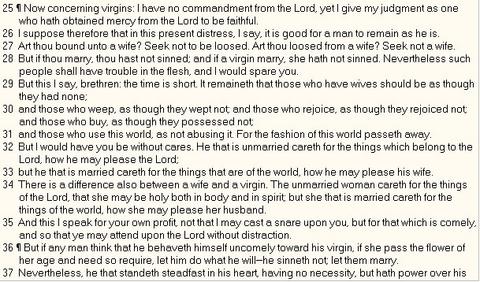
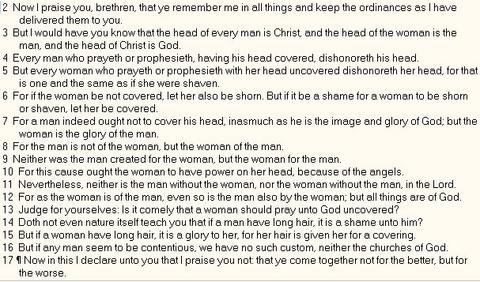

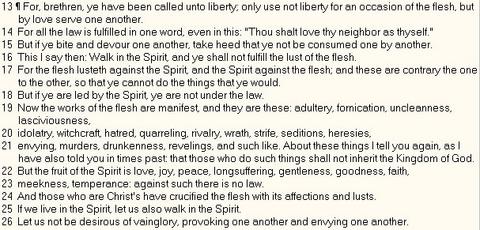
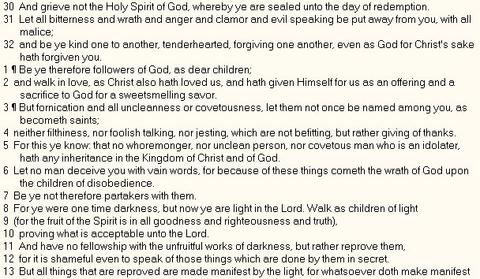

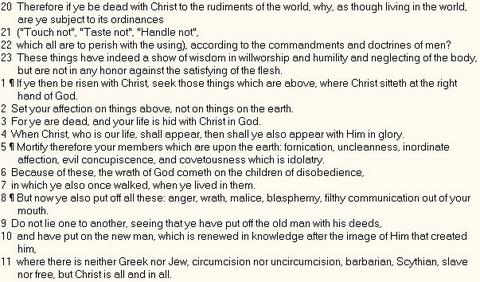
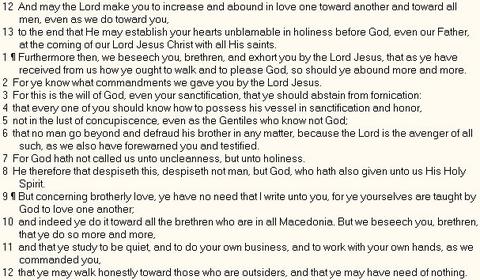
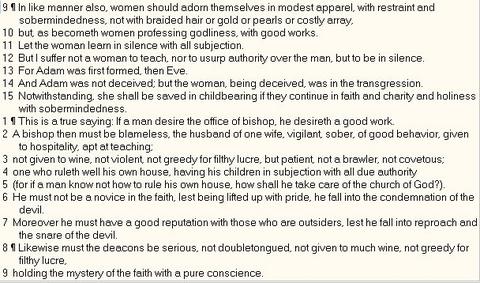

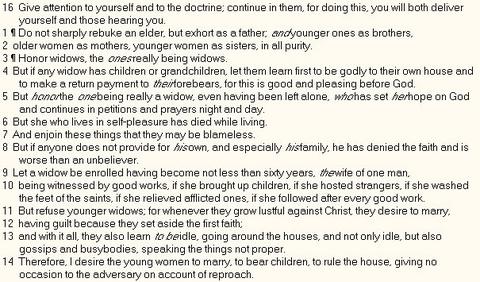
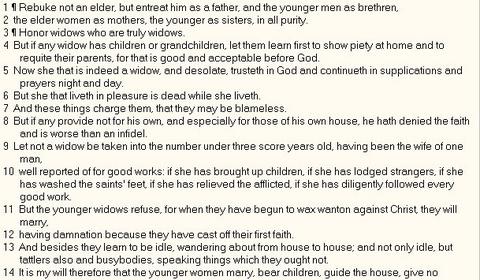
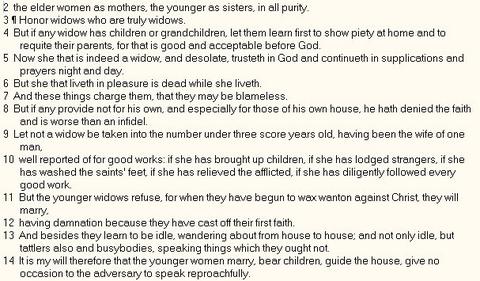
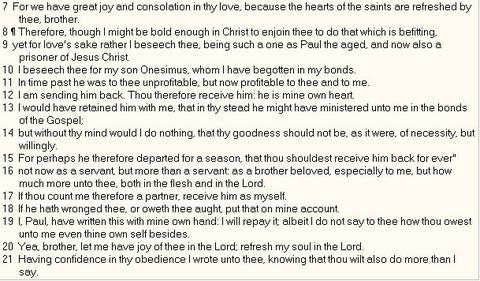
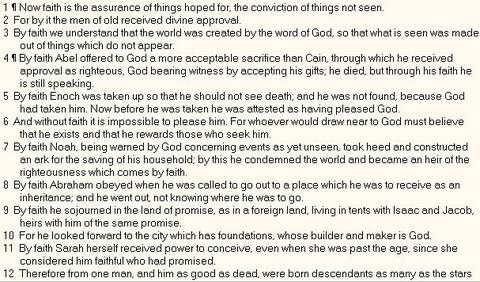
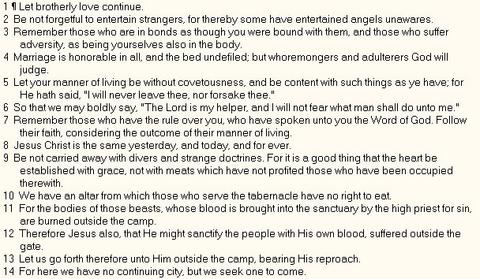
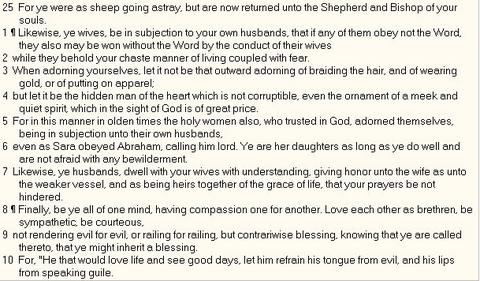
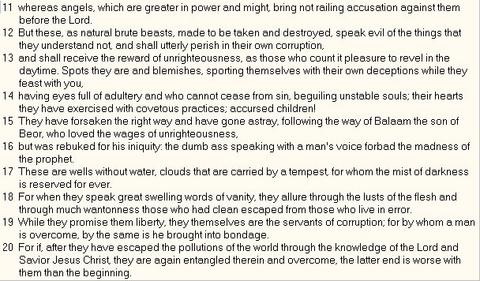

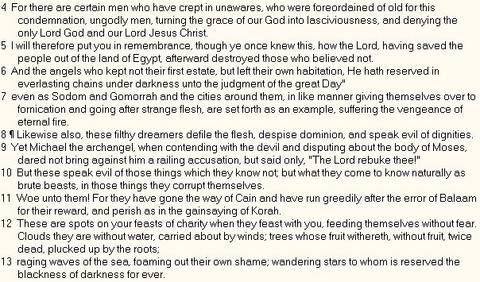

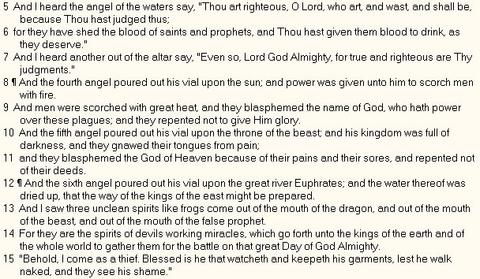
John 19:15 They [the jews] cried out, "Away with Him, away with Him, crucify Him!" Pilate said to them, "Shall I crucify your King?" The chief priests answered, "We have no king but Caesar."
Matthew 27:25 And all the people answered, "His blood be on us and on our children!"
Romans 3:25 whom God put forward as an expiation by his blood, to be received by faith. This was to show God's righteousness, because in his divine forbearance he had passed over former sins
Romans 5:9 Since, therefore, we are now justified by [Christ's] blood, much more shall we be saved by Him from the wrath of God.
Ephesians 1:7 In Him we have redemption through His blood, the forgiveness of our trespasses, according to the riches of His grace
Revelation 1:5 . . . from Jesus Christ, The Faithful Witness, The First-Born of the dead, and The Ruler of kings on earth. To Him who loves us and has freed us from our sins by His blood
Revelation 1:6 and made us a kingdom, priests to his God and Father, to Him be glory and dominion forever. Amen.
Hitler Ranting Against the jews
Destined-to-be-damned "orthodox-jewish" heretics speak:
The type of "jew"
who caused Hitler and his followers to do
what they did and what will happen again
according to Daniel chapter 12 and Revelation 13
Ditto #1
Ditto #2
Ditto #3
Ditto #4
Ditto #5
These orthodox Jews apparently find witnessing messianic gentiles(?) fascinating:
Talkative and Interested!
Israeland



A [permanent] concubine is a woman who is spouse to a [perhaps already "legally" married] husband
with whom she is not "legally" married, [though not criminally immoral],
and thus neither technically a "mistress" nor thereby "sinful" - thus not guilty of "bigamy".
/just_got_to_do_it






















































































